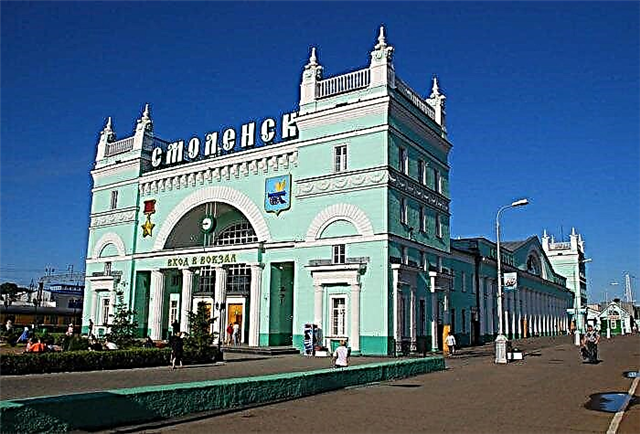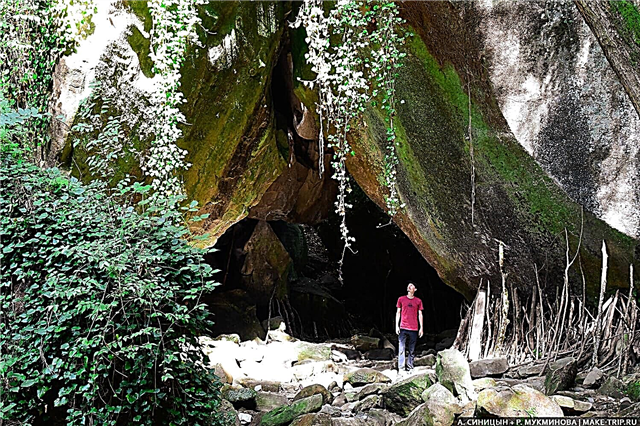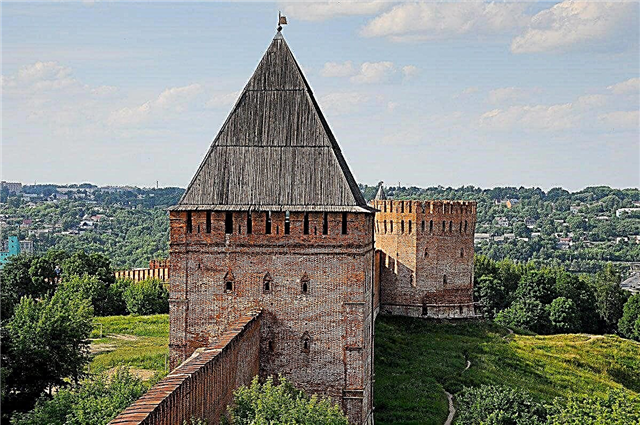Since the 9th century, Cathedral Mountain has been the focus of the cultural and religious life of Smolensk. A long main staircase leads to the magnificent architectural ensemble at its top. The mountain offers a beautiful view of the city and picturesque river landscapes of the Dnieper. Major battles of the wars of 1812 and 1941-1945 were fought near Smolensk. In memory of these tragic events, memorials and monuments have been erected in the city.
Smolensk is a city with a rich history. It is mentioned in the annals even earlier than Moscow. Many architectural monuments have been preserved in it. Three surviving churches of the pre-Mongol period are considered unique structures. Several towers and fragments of the fortress walls have survived from the fortress that defends the city from enemies. There are many beautiful squares near the wall, and museum expositions are located in the towers.
The most interesting and beautiful places
List, photos with names and descriptions of the best attractions of Smolensk. He will help you plan routes for exploring the top places of the city and its environs in 2-3 days.
Smolensk fortress wall
It was built at the end of the 16th century and had an important defensive significance for the city. To date, half of the six-kilometer wall has survived, 18 out of 38 towers have survived. But even the remains of the fortress wall have an impressive appearance - its width reaches 6 meters, and its height is 19 meters. Tourists are not allowed to enter the wall and the towers; they can be viewed from the outside. Access is only possible in the towers where the museum exhibits are located.

Assumption Cathedral
Located on Cathedral Hill in the city center. An excellent view of the city opens from the walls of the cathedral. The Assumption Cathedral was erected on the site of a 12th century wooden church in 1677. The temple was built in the Baroque style. It is crowned with blue domes with gilded crosses. The iconostasis of the temple is interesting - it is 30 meters high. The architectural ensemble of the cathedral also includes a bell tower, carriage buildings and chambers.

Dnieper embankment
A favorite place for walking for residents and guests of the city. The three-level embankment partially adjoins the Pyatnitskaya tower of the fortress wall. The upper level is considered the main one; it has a length of 865 meters. This is a cobbled boulevard, around which trees are planted, flower beds are laid out, benches are installed, playgrounds for children are equipped. The levels are connected by stairs and ramps.

Bolshaya Sovetskaya Street
The main street of the city, built up with public and residential buildings of the 19th century. Some of them were badly damaged during the war, but were restored. The street stretches through the entire historical center of the city from Victory Square to the bridge over the Dnieper. In the early 2000s, tram rails were removed from it and paved with paving stones. The most interesting buildings on the street are the House of Books, the Trinity Monastery complex, the former Evropeyskaya Hotel.

Smolensk Art Gallery
It is located in the luxurious building of the former Alexander Real School. The basis of the expositions during the creation of the gallery in 1920 was made up of the nationalized private collections of the nobility. Collected works of Russian art from the 18th century to the present. A separate collection of art from the Soviet period is highlighted. The Western European exhibition is represented by works by painters from Italy, Germany, the Netherlands and Spain.

Square of victory
Located near the fortress wall in the Leninsky district. Previously it was named Molokhovskaya, Krasnoarmeiskaya and Smirnov Square. It received its modern name in 2010, at the same time the Victory Obelisk was laid on it, opened 5 years later. Also in 2015, a monument to the Defenders of Smolensk was unveiled. On the square there are buildings that are cultural heritage objects - the cinema "October" and the former store "Detsky Mir".

Deer Sculpture
Initially, the sculpture by the German master Richard Frize was located in the Rominsten Forest on the territory of Kaliningrad, formerly East Prussia. The bronze deer has a real prototype - a deer with especially ornate antlers, shot by Kaiser Wilhelm II. The emperor liked the trophy so much that he commissioned a sculpture for it. Now the sculpture of a deer pleases children on the site of the Blonie Garden.

Church of the Immaculate Conception of the Blessed Virgin Mary
Nowadays inactive Catholic church. Built in the neo-gothic style in 1896. The imposing temple building accommodated up to 3,000 parishioners. There have been no divine services since 1937. The city archive was kept in the church for many years. Since 2016, a project has been developed for the reconstruction of the building and its conversion into an organ concert hall. Outwardly, the temple is very interesting - its thin spiers and lancet windows are directed into the sky.

Memorial "Mound of Immortality"
Created in memory of the courage and heroism of the Smolyans in the battles with the fascist troops. The War Memorial is located in Readovsky Park. The hill was built from earth collected from mass graves and military cemeteries of the Smolensk region. The mound is 8 meters high and its base is 40 meters in diameter. At its top there is an 11-meter obelisk in the form of an open book, in which large numbers "1941-1945" are carved.

Smolensk Fortress Towers
The main decoration of the fortress walls are their powerful towers. They were of particular importance in the defense of the city. All of them were different in shape, today you can see some of the surviving towers.
Thunder Tower
The most visited tower of the fortress wall. It was built in the 17th century. Despite its defensive purpose and impressive appearance, it looks quite graceful, its multifaceted shape and loopholes under the roof are unusual. Within the walls of the tower there is a museum "Smolensk - the shield of Russia". There are ticket offices on the ground floor of the tower, and to view the exposition, you need to climb to the second floor along a steep staircase inside the wall.

Nikolskaya tower
Triangular tower, next to which there is a passage arch. During the occupation, the tower lost its roof, which was restored during restoration work. At present, the tower houses the country's oldest flax museum "Smolensk Flax". Visitors to the museum will learn in detail about the history of flax growing in the Smolensk region, see the tools used to process flax, and see a collection of flax products.

Dnieper gate
Built in the 18th century. Located in the area of the Dnieper embankment. The two-storey passage gates were built in the classical style on the site of the destroyed Florovskaya tower. The second floor above the passage arch was occupied by the gateway temple of Odigitria. Earlier, a wide bridge, destroyed during the Great Patriotic War, led to the gate. Some of the abutments have been preserved from the bridge at the gate. Nowadays there is a parish school in the premises of the gate.

Eagle Tower
A corner, deaf tower, strongly protruding beyond the wall. Such an arrangement in relation to the wall made it possible to effectively fight and defend the walls. The defenders of the tower, being in cover behind the powerful battlements, could fire at enemies at the very wall. The tower has 16 faces, so from a distance it seems that it is round. An auditory passage was laid under the foundation of the tower, now filled up. The entrance to the tower is walled up.

Kopyten tower
The quadrangular gate tower preserved in its original form. It has not been used for its intended purpose since the time of Catherine II, when the gate was repaired. For a long time, the tower kept the archives of the Smolensk province. The tower is located in the Pushkin Garden, and is partially adjacent to the earthen rampart. A bust of Pushkin and a fountain are installed in the center of the garden. Near the fortress wall there is a reservoir, the waters of which cascade from pool to pool.

Gardens and parks of Smolensk
The city has beautiful park areas, including the historical gardens - Lopatinsky and Blonie.It is nice to walk along the well-groomed alleys and relax on a bench here.
Lopatinsky garden
Created by order of Governor Lopatin in 1874. The landscape park was located between the ramparts of the Royal Fortress, a restaurant, gazebos, and a summer theater appeared on the site of the former prison and guardhouse. Bridges were thrown across the pond between the ramparts, one of which, the Bridge of Sighs, has survived to this day. In 1912, Emperor Nicholas II visited the Lopatinsky Garden. Currently, the garden houses many attractions and retail outlets.

Blonier Garden
It was founded in 1830 on the site of a bridgehead for soldiers by order of Nicholas I. There are sculptures of deer and lions in it. There is also a monument to the composer Glinka in the garden. Famous foreign artists and musicians came to the opening ceremony of the monument in 1885. Music written by Glinka is playing from the speakers on the poles. Since 2009, the park has been decorated with openwork wrought-iron arches. In the center of the garden there is a beautiful light and music fountain.

Square in Memory of Heroes
Located in the city center near the Smolensk fortress wall. The square was created in honor of the 100th anniversary of the victory over Napoleon's troops and at the time of its opening was called "Boulevard of 1812". The boulevard was personally opened by Emperor Nicholas II. Near the fortress wall there is a mass grave of soldiers who gave their lives for the Fatherland. A bust of Kutuzov and one of the most famous monuments of Smolensk - "Monument with eagles" are installed in the park.

Readovsky park
The park recreation area is located on the slopes of the Yasnaya River. Once upon a time there was a manor of the old noble family of the Reads, after which the park was named afterwards. Fruit orchards, ash trees, poplars, maples and lindens have been preserved in the park since the time when it was the territory of the Zelenstroy farm. Alleys are laid between the groves. The park has a spring and a pond where you can swim. In the center of the park is the Mound of Immortality.

The main monasteries of Smolensk
The monasteries are located in the historical center of the city, on Cathedral Hill and near the fortress wall. The oldest was founded in the XIII century.
Holy Trinity Monastery
Convent on the historic Bolshaya Sovetskaya street. The main Trinity Cathedral of the monastery was erected at the end of the 17th century. The bell tower and the tomb were added to the cathedral in the 18th century, and the Church of the Annunciation was erected. The church and the cathedral have features inherent in Christian architecture. The bell tower, located across the street from the monastery in a separate building, was built in the European style.

Spaso-Preobrazhensky Avraamiev Monastery
It is considered the oldest monastery in Smolensk. According to ancient documents, the monastery was founded in the 13th century by the Smolensk Bishop Ignatius. Until the 17th century, it was part of the Smolensk Fortress. Almost all of its stone buildings date back to the 18th century. During the war of 1812, the French placed an infirmary in the monastery; after their departure, the monks rebuilt the burnt and destroyed monastery for several years.

Monuments and monuments of Smolensk
There are many historical and modern monuments in the city. They adorn the streets and squares of Smolensk, remind of historical events and outstanding personalities.
Monument "Grateful Russia - Heroes of 1812"
Also known as the Eagle Monument. It is considered the best artistically executed monument in the city. Installed in the Heroes Memorial Square in honor of the victory in the war of 1812. The monument embodies the courage of the Russian army. It is made in the form of a large rock, on the top of which there is a nest. A warrior in Roman armor makes his way to him, and large eagles defend their nest. The height of the monument is almost 10 meters.

Read also: 30 main monuments of Smolensk.
Monument to Mikhail Kutuzov
Installed in 1954 near the Assumption Cathedral. For the liberation of Smolensk from Napoleon's troops, Kutuzov received the title of "Prince of Smolensk". The sculptor Motovilov was inspired in his work by the image of the commander created by Tolstoy in the novel War and Peace. The bronze figure of Kutuzov is mounted on a pink granite pedestal. The sculpture is 3.5 meters high. The appearance of a commander shows his firm will and determination.

Monument to Prince Vladimir
Installed in 2014 on the Dnieper embankment. The sculpture of the Grand Duke of Kiev and Novgorod is 4 meters high, it stands on a pedestal 5 meters high. In one hand, he squeezes the cross, the other stretches forward as if calling everyone to undergo the rite of baptism. The author of the monument to the prince, called the Baptist of Russia, was personally chosen by Patriarch Kirill. It was the artist and sculptor V. Grashchenkov.

Monument to Fyodor Kon
The monument to the builder of the Smolensk Fortress was erected in 1991 at the Thunder Tower. Historians do not know the true story of his life, it is believed that he studied the skill of an architect in Europe. The sculptor of the monument O. Komov depicted the architect sitting on a stone and pensively examining the wall of the fortress. His hand rests on an old wooden compass. Project architect - A. Anipko.

Monument to Alexander Tvardovsky and Vasily Turkin
Located on Victory Square near the Museum of the Great Patriotic War. Depicts a front-line poet conducting a friendly conversation with his hero Vasily Terkin. Smolensk sculptor Sergeev Albert Georgievich worked on the bronze figures. The opening of the monument took place in 1995. This is the only monument in the country depicting Tvardovsky with his fictional character. On Victory Day, fresh flowers are brought to the monument.

Monument to the defenders of Smolensk August 4-5, 1812
The memorial keeps the memory of the battle near Smolensk in the war of 1812. The monument is located in the Lopatinsky Garden. The order to erect the monument was given by Emperor Nicholas I. According to his decree, several cast-iron monuments were made, which they planned to install in places of important battles. It was installed in Smolensk in 1841. The height of the monument is 26 meters. There is a gilded cross at the top of the stele.

Monument to the Sofia Regiment
Installed in Lopatinsky Garden on the Royal Bastion in memory of the regiment that took part in the war of 1812. It is a tall four-sided obelisk, at the top of which is the figure of an eagle, which spread its wings in flight. In the lower part of the pedestal there are 6 semi-columns with niches, in which there are bronze plaques with the stories of the regiment. The author of the project was a soldier of this regiment, the sculptor Tsapenko. The monument was opened in 1912.

The best museums of Smolensk
The most interesting museums in the city, which are definitely worth visiting.
Smolensk Historical Museum
Opened in 1888. It includes 12 branches in Smolensk and 5 more in the region. The main building is located at the Bologna Garden. It combines three areas of the history of the region - archeology, ethnography and natural science. Items from the 9th-10th centuries are exhibited - jewelry, swords, gold solids. There are also exhibitions devoted to painting, weapons, numismatics, and rare books. The funds of the museum amount to more than 600,000 exhibits.

Museum of Sculpture S. T. Konenkov
The Memorial Museum is located in an apartment on Tverskaya Street, where the sculptor has lived since 1947. The museum was founded in 1974. In the rooms, the atmosphere of Sergei Timofeevich's life is recreated - a study, a hall, a living room, a bedroom. The interior of the rooms was created by Konenkov himself. The workshop is located in a separate exposition. The museum contains about 5,000 items - photographs and personal belongings of the sculptor, his works.

Museum "Smolensk region during the Second World War"
One of the most frequently visited museums in Smolensk. It opened in 1974 in the Heroes Memorial Park in the building of a former school. The exhibits of the museum tell about the Smolensk battle. It displays the weapons of both armies, military awards, military uniforms. There is a diorama with the sound "The Birth of the Soviet Army", a partisan dugout has been reconstructed. There is a platform with military equipment in the open air.

Museum "In the world of fairy tales"
The museum, aimed at a children's audience, is located on Lenin Street.His exhibitions feature plots of Russian folk tales and Pushkin's tales. They used items from the collections of the Historical Museum - a sled, a 19th century chest, toys made by artisans. The characters of fairy tales - Baba Yaga, Leshy, Vasilisa the Wise, entertain children and tell interesting facts.

Museum-apartment of A. Tvardovsky
The museum is located in an ordinary apartment of a four-story building in Zapolny Lane. Tvardovsky lived here in 1943-1944, when he came to Smolensk as a war correspondent. In this apartment he wrote several chapters of the famous poem about Vasily Terkin. The museum opened in 1990 recreates the interiors of the war years. Exhibited are editions of Tvardovsky's books of different years, his photographs and documents, letters.

Cultural and Exhibition Center named after Tenishevs
Opened in 2013. The modern building of the center attracts attention with its architectural appearance. It was built in the Art Nouveau style with a blue glass facade. The initiators of the creation of the center are the patrons of the Tenishevs. The exhibition halls have a total area of 2,000 m². One of the permanent exhibitions is dedicated to the work of the Andronov glassblowers. Temporary exhibitions feature works of contemporary art.

The main theaters of Smolensk
The best theaters in the city, where you can see classical performances or performances based on children's art.
Drama theater named after A.S. Griboyedov
It was founded back in 1780 - then the governor of the city organized an "opera house" especially for the arrival of Catherine II. The modern building has been located since 1939. It was built according to the project of the architect from Moscow Ilyinsky. The neoclassical style of the building perfectly suits the main repertoire of the theater - classical performances of masterpieces of world drama. Experimental performances are shown on the small theater stage.

D. N. Svetilnikov Puppet Theater
Located in the city center. Performances are shown in two halls. Both are equipped with modern technology, which allows for spectacular and high-quality performances. The performances are staged based on Russian folk tales and children's works of art. There are several puppet shows for adults. In addition to performances, festive events and fun contests are held for children.

Smolensk chamber theater
The theater performances are shown in the building of the former Yubileiny cinema on Nikolaev Street. The theater was founded in 1989, then its main building was the Zaaltarnaya Tower of the Smolensk Fortress Wall. The performances are designed for different age groups. Some of the performances are designed for young spectators, they are shown in the morning. For adults, they stage unusual interpretations of classical pieces.

Smolensk temples of pre-Mongol time
The main historical places of worship in Smolensk can be considered three preserved temples of pre-Mongol times. They were built in the XII century.
Church of Michael the Archangel on the Pier
Located on a hill in the Leninsky district. The name "Svirskaya" is also known - presumably due to the fact that the northern trade routes passed nearby. Presumably the church was founded at the end of the 12th century. During the seizure of the city by the Commonwealth, a Catholic church was located there. The building was partially destroyed and rebuilt several times. Now the church has returned to almost its original appearance.

Church of Peter and Paul on Gorodyanka
Built in 1176. Located at the train station. It is considered the oldest preserved church in the city. Its appearance differs from the usual Christian buildings. The church was built of rough red bricks and has a simple, laconic appearance. The church was built as the house church of Prince Rostislav Mstislavovich. On the site of the tower where he lived in the 18th century, the church of St. Barbarians - a white temple with a bell tower.

Church of St. John the Evangelist on Varyazhki
It is located on a low hill on Bolshaya Krasnoflotskaya street. Built in the XII century. The one-domed four-pillar church with its austere and simple appearance resembles the Church of Peter and Paul. Fragments of the original frescoes have been preserved inside. On the outer corners, there are crosses made of thin fired bricks. In the 18th century, the upper part of the church was rebuilt; some of the buildings were destroyed during the Great Patriotic War.

Historical buildings and structures of Smolensk
Interesting objects of civil architecture and urban planning.
Station "Smolensk-Central"
The station operates in 1868. Initially, the station had two passenger stations connected by an arch. They were badly damaged during the German bombing of Smolensk; after the war, the station was actually rebuilt. The building of the new railway station was built in a neoclassical style, and it looks harmonious in comparison with the old city buildings surrounding it.

Engelhardt House
An architectural monument located in the Heroes Memorial Park near the fortress wall. A house was erected at the end of the 19th century for the head of Smolensk, Engelhardt. It is a two-story building, with asymmetric one-story ledges attached to the sides. The style of the building is eclectic, with many decorations on the façade. There is a large lobby at the entrance to the building, and a three-flight staircase leads to the mezzanine. There is a Wedding Palace in the house.

City smithy of the 17th century
Located in the courtyard of the Smolensk Historical Museum. The building of the smithy was built at the beginning of the 17th century and initially housed an archive. Now it houses a museum that tells about blacksmithing. The atmosphere of the workshop is recreated in it - there are furs, forges, an anvil. A guide in the guise of a blacksmith tells about the peculiarities of this difficult craft. The museum's collection contains items of the 17th-19th centuries - sickles, weapons, keys, nails.

Where can you go from Smolensk?
In the vicinity of the city there are many interesting and beautiful places where you can go on weekends by car. We recommend visiting the "Smolensk Poozerie", relaxing away from the city and enjoying the beauty of glacial lakes.
Memorial complex "Katyn"
The memorial complex is dedicated to the victims of political repression. This is the territory of a military cemetery 15 km from the city in the Katyn forest, where more than 4,000 Polish officers were buried, shot by the NKVD, more than 6,000 victims of Stalin's repressions and about 500 Soviet soldiers shot by the German invaders. The sculptural composition "Shooting" has been unveiled, the names of the dead people are engraved on the Wall of Memory.

Historical and architectural complex "Teremok"
The former estate of Princess Tenisheva, 18 km from Smolensk, where she founded an art center at the turn of the 19th and 20th centuries. The Center for Art and Education was visited by Chaliapin, Vrubel, Stravinsky. Nicholas Roerich became the author of the mosaic panel "Savior Not Made by Hands" in the Church of the Holy Spirit. The most striking object on the territory of the complex is the prince's house, which looks like a tower from folk tales. It houses an art exhibition.

National Park "Smolenskoe Poozerie"
National park in the Smolensk region, 120 km from the city. It has many beautiful lakes with picturesque landscaped coastlines, most of which are of glacial origin. Lake Sapsho is considered the most beautiful. There are hiking trails for independent walks in the park, there are organized excursions to the Dead Lake, through the wetlands. The historical route "Along the front line" is interesting.












